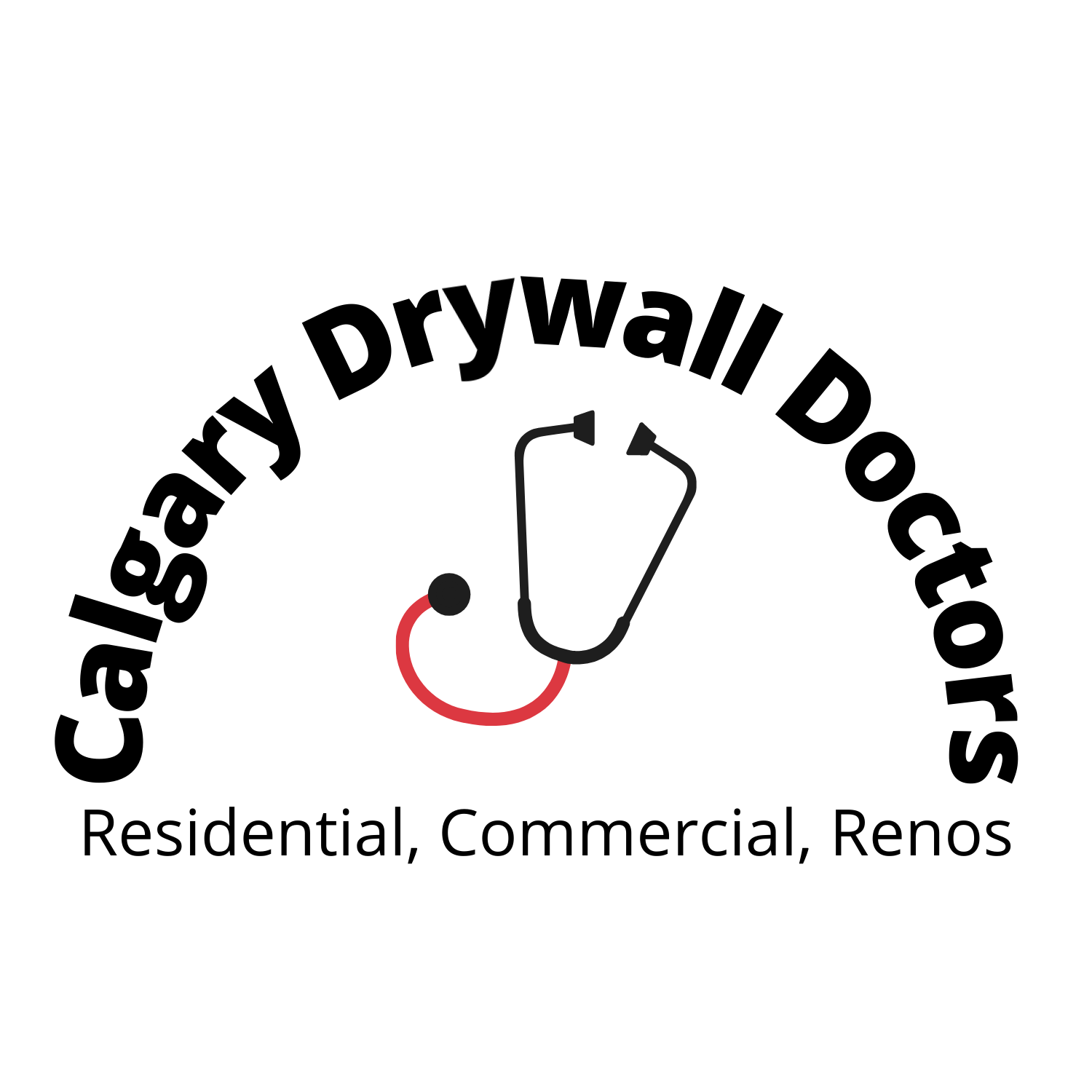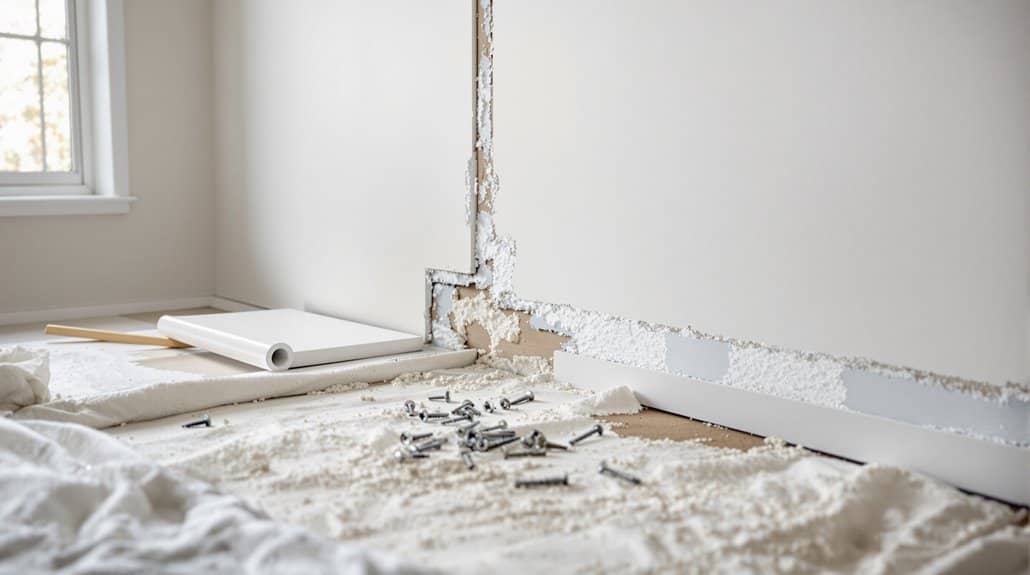When planning your drywall installation, you’ll need to account for five key expense factors that determine your total investment. These include material quality and selection costs ($0.24-$2.25 per square foot), labor rates ($1.60-$2.35 per square foot), project scope calculations, surface preparation requirements, and crucial equipment investments. Understanding these cost components helps you develop an accurate budget and avoid unexpected expenses. Let’s examine each factor in detail to guarantee your project’s success.
Key Takeaways
- Material costs vary significantly, with standard drywall at $0.24-$0.41 per square foot and specialty options reaching $2.25 per square foot.
- Professional labor rates range from $30-$70 per hour, with average installation costs at $3.75 per square foot.
- Project size affects pricing through waste allowances, service charges, and installation fees, typically requiring 10% extra material.
- Surface preparation and remediation can increase costs by 20-30%, including repairs, mold treatment, and moisture protection.
- Essential equipment investments range from basic hand tools to specialized machinery like drywall lifts, totaling $275-$720.
Material Quality and Selection Costs
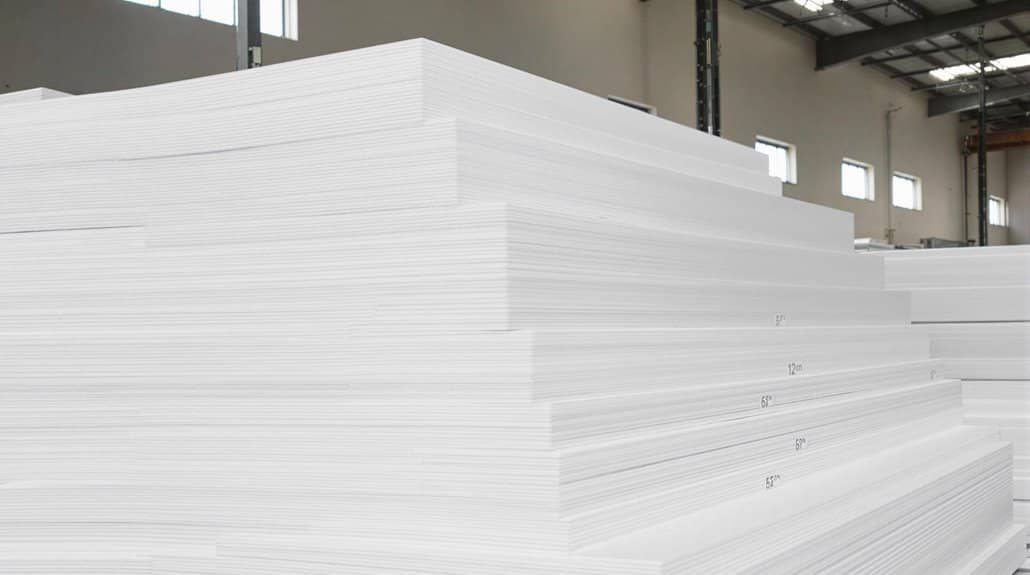
Building materials form the foundation of any drywall installation project, with costs varying greatly based on quality and specific requirements. You’ll find standard drywall materials ranging from $0.24 to $0.41 per square foot, while specialty options like moisture-resistant drywall start at $0.40 per square foot.
When you’re planning your material costs, consider that soundproof drywall can greatly impact your pricing guide, running between $0.95 to $2.25 per square foot. You’ll also need to factor in crucial finishing materials like joint compound, calculated at 0.053 pounds per square foot, and drywall tape. While paper tape is more economical, you might prefer fiberglass mesh tape for its superior quality and durability, particularly in areas requiring improved performance. These choices directly influence your project’s overall material expenses. Fire-resistant drywall tends to increase material costs significantly compared to standard options.
Labor Rates and Time Requirements
When planning your drywall installation budget, labor costs will typically constitute the largest portion of your expenses, ranging from $1.60 to $2.35 per square foot. You’ll need to take into account the total labor time of approximately three days, with crews working 6-7 hours daily. The complexity of the project and number of extra workers directly impact your final costs.
| Cost Factor | Impact on Budget |
|---|---|
| Base Labor Rate | $1.60-$2.35/sq ft |
| Average Installation | $3.75/sq ft |
| Unbillable Hours | 15-20% increase |
To get an accurate estimate, you’ll need to take into account unbillable hours for prep and cleanup. Keep in mind that while larger crews might complete the job faster, they’ll increase your total labor costs. Standard drywall installation typically requires a two-person team for best cost-efficiency. Professional contractors charge hourly labor rates between $30 to $70 for installation and finishing work.
Project Scope and Square Footage
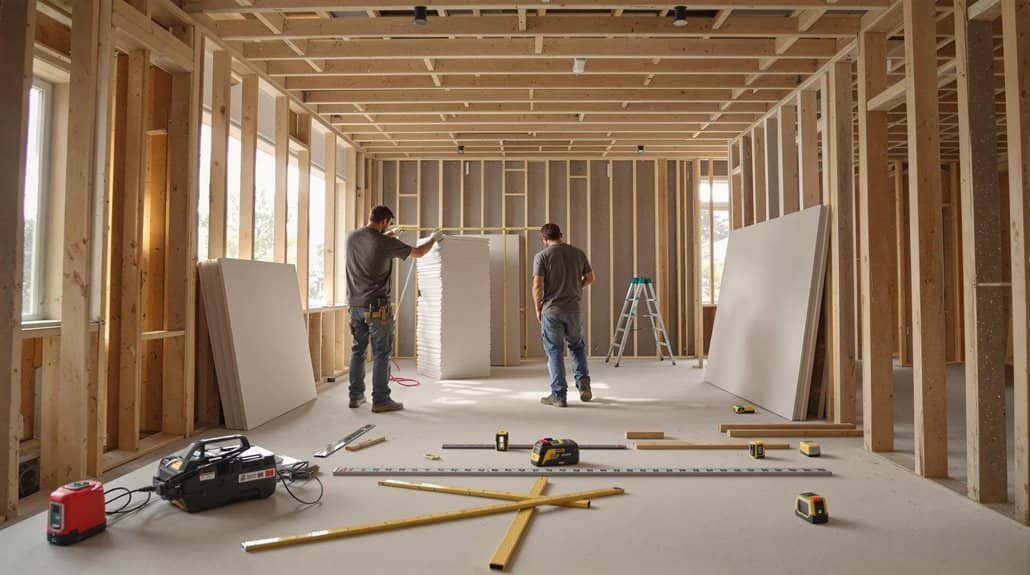
Understanding your project’s exact square footage directly affects both labor costs and material requirements. When estimating the cost of your drywall installation, you’ll need to calculate the total square footage by measuring each wall’s width and height, including ceilings and bulkheads. To verify accurate estimates, consider these crucial cost factors:
- Standard drywall sheets (4’x8′) cover 32 sq ft, while larger sheets (4’x12′) cover 48 sq ft, affecting materials required
- Add 10% to your total square footage for waste and cutting allowances
- Factor in extra expenses like service charges ($0.24-$0.70/sq ft) and installation costs ($1.50-$3.00/sq ft)
Your project scope should account for all surfaces requiring drywall, including windows and architectural features. This thorough approach helps you develop precise material calculations and budget forecasts. Professional contractors can prevent costly mistakes and ensure quality finishes, especially for complex installations requiring specialized expertise.
Surface Preparation and Special Conditions
Proper surface preparation greatly impacts your drywall installation’s success and longevity. You’ll need to factor in supplementary fees of 10-15% for vital repairs and cleaning to guarantee surfaces are moisture-free and stable. When dealing with special conditions like mold or water damage, expect labor costs to increase by 20-30% for specialized remediation techniques.
For uneven surfaces, you’ll require extra framing or furring strips, adding $1.00-$2.00 per square foot to your installation costs. If you’re working in high-humidity areas, investing in moisture-resistant drywall is imperative, though it costs 10-30% more than standard options. Don’t forget to account for disposal fees ranging from $50-$150 when removing old drywall, as local regulations may affect waste management costs. Purple drywall options provide superior moisture and mold protection for basement installations, making them worth the additional investment.
Equipment and Tool Investments
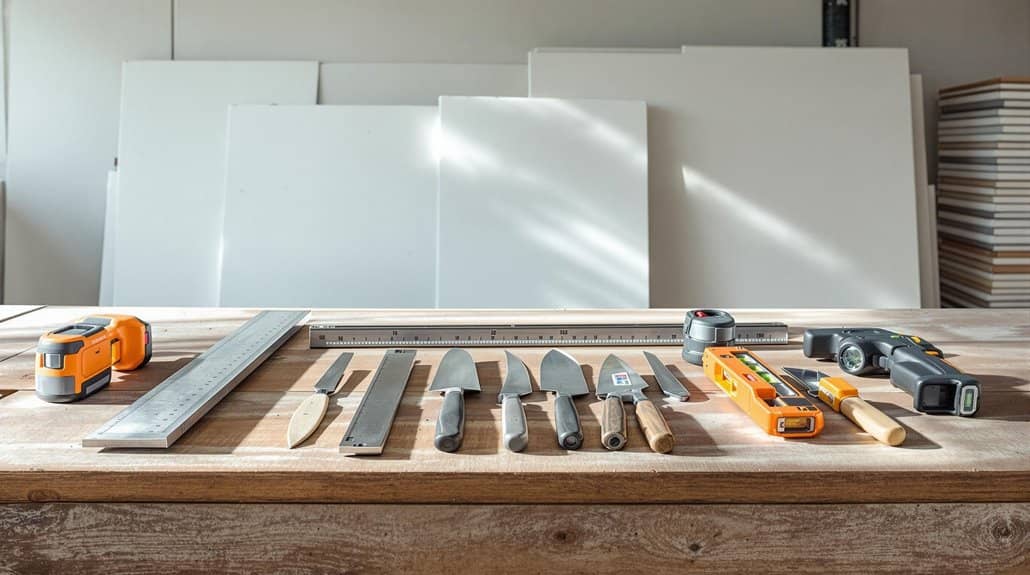
Successful drywall installation requires strategic investment in vital tools and equipment to optimize efficiency and quality. You’ll find that smart investments in fundamental equipment can greatly reduce labor costs and minimize waste throughout your projects. Your initial investments should focus on primary tools that deliver the highest value for professional-grade installations.
- A drywall lift ($200-$500) proves invaluable for ceiling work, dramatically improving efficiency and safety
- Basic hand tools like utility knives ($10-$30) and measuring equipment ($15-$40) guarantee accurate measurements and precise cuts
- Power saws ($50-$150) speed up your workflow while maintaining professional results
Consider purchasing a complete installation tool kit to save 10-15% on your equipment investments. These all-encompassing sets provide all necessary tools while offering better value than individual purchases, helping you maintain competitive pricing for your services. High-quality materials are essential for achieving the durability and aesthetic results that meet professional standards.
Frequently Asked Questions
How to Estimate Drywall Costs?
You’ll need to measure total square footage, add 10% waste factor, multiply by drywall materials cost ($0.24-$2.25/sq ft), and include labor expenses ($1.50-$3.00/sq ft) plus finishing costs ($1-$1.50/sq ft).
What to Charge to Hang Drywall?
You’ll need to charge $1.50-3.00/sq ft for basic drywall installation, factoring in your labor costs, material quality, and regional pricing. Consider project size and complexity when calculating final rates for your customers.
What Is the Profit Margin for Drywall?
You’ll typically aim for a 15-20% profit margin in drywall work, adjusting for material costs, labor expenses, and regional differences. Your pricing strategy should balance market trends while remaining competitive to maintain sustainable profitability.
How Do You Quote Drywall Finishing?
You’ll need to measure total square footage, assess finish level (0-5), calculate labor costs ($1-2/sq ft), add material expenses, and factor in texture techniques and surface prep. Don’t forget cleanup and timeline considerations.
Conclusion
Understanding these five key expense factors will help you accurately budget for your drywall installation project. You’ll need to weigh material grades against durability requirements, calculate labor costs based on regional rates, assess total square footage, factor in surface remediation needs, and determine necessary equipment investments. By methodically evaluating each component, you’ll develop an all-encompassing cost framework that prevents unexpected financial overruns during implementation.
